The Samsung Galaxy Tab S2 Review
by Brandon Chester on October 15, 2015 8:00 AM ESTSystem Performance
Tablets have always been devices where performance can be pushed further than a smartphone. There's much more thermal headroom and bigger batteries to drive high performance SoCs. Both Apple and NVIDIA have SoCs that cannot feasibly be put in a smartphone due to their heat and power usage, and these chips find their way into tablets where these factors can be managed and the additional performance can be utilized by more sophisticated applications. At the same time, some vendors opt to use the same silicon in both phones and tablets. In the case of the Galaxy Tab S2, Samsung has decided to use their Exynos 5433 SoC which previously shipped in the Galaxy Note 4 Exynos.
The CPU side of Exynos 5433 is a quad core Cortex A57 cluster with a max frequency of 1.9GHz, and a quad core Cortex A53 cluster with a max frequency of 1.3GHz. The GPU is ARM's Mali-T760 MP6 GPU with a max frequency of 700MHz. On average the results should be similar to the Galaxy Note 4 Exynos, although software improvements to both the browser as well as Android itself will obviously have an impact.
As always, the first group of tests are our web browser tests to characterize JavaScript performance, followed by BaseMark OS II and PCMark to evaluate the CPU and other aspects of a device's performance.
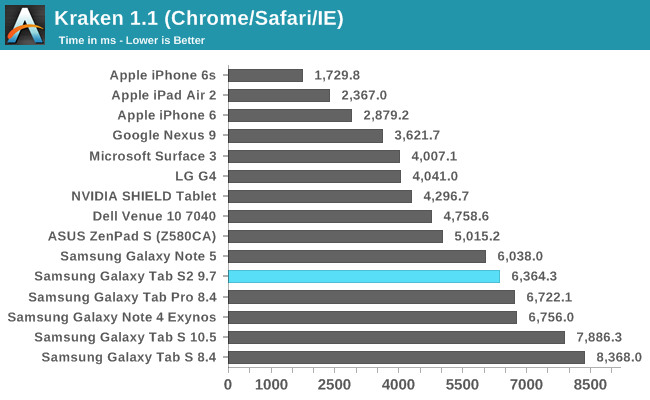
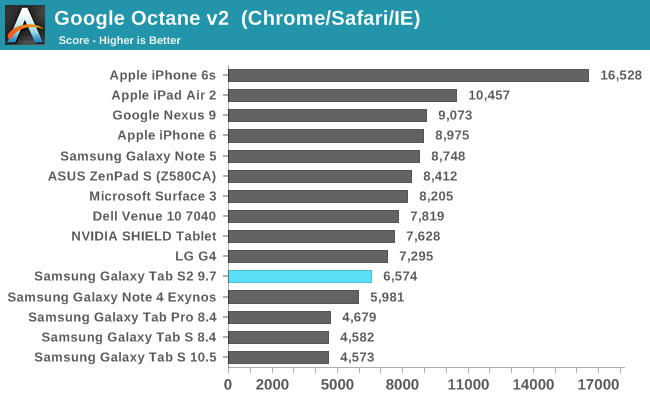
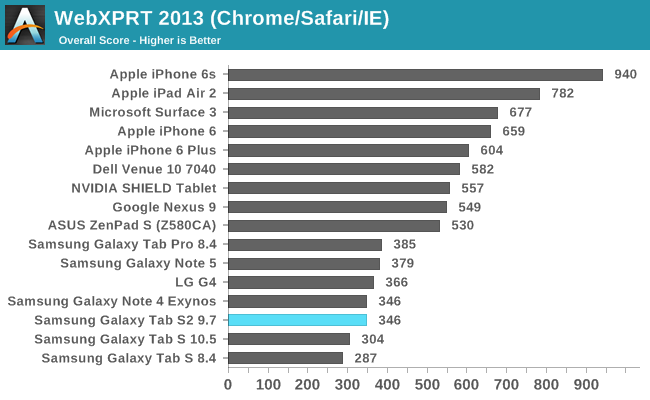
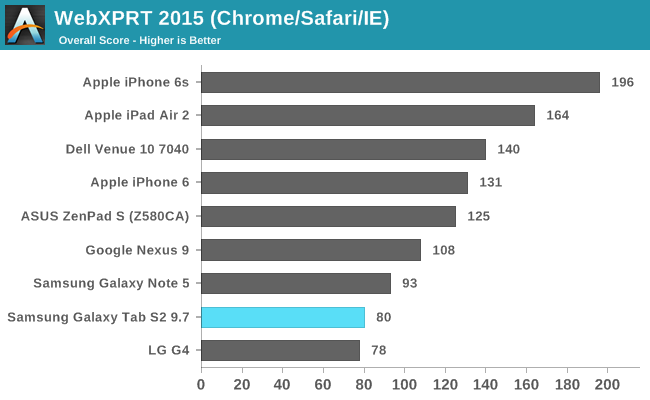
Android, and most specifically Chrome's lackluster JavaScript performance is something we've been commenting on for a while now. On top of that, the Galaxy Tab S2 simply doesn't have Samsung's latest and greatest SoC, and these factors combined together give results that aren't very impressive when one considers how much better the iPad Air 2 performs despite being over one year old at this point.
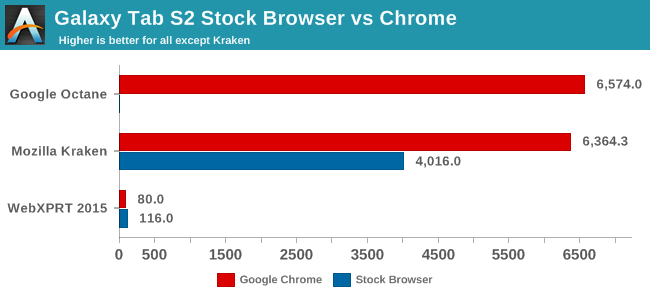
Looking at the Javascript performance in Samsung's stock browser provides some interesting but not unexpected data. It's clear that there's a much higher degree of optimization for Samsung's SoCs in their own browser than in Chrome, which isn't surprising. However, Samsung's browser isn't without its own issues. It actually crashes in the zlib test of Google Octane, and although the incomplete score of 7354 is higher than what Chrome achieves, the fact that the JavaScript code couldn't be properly executed points to some more concerning issues than performance
The other problem with using a device's stock browser for comparisons is that Android devices shipping with Google Mobile Services also include Chrome, and in my experience users are far more likely to utilize Chrome based on their awareness of the Chrome brand than they are to use the included OEM web browser. In short, while stock browser results may give a better idea of what kind of JavaScript performance a device is technically capable of, the Chrome results are more relevant when examining the performance and experience that the average user will have.
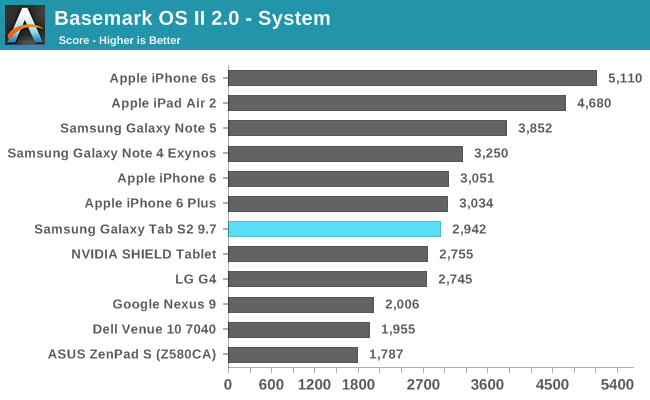
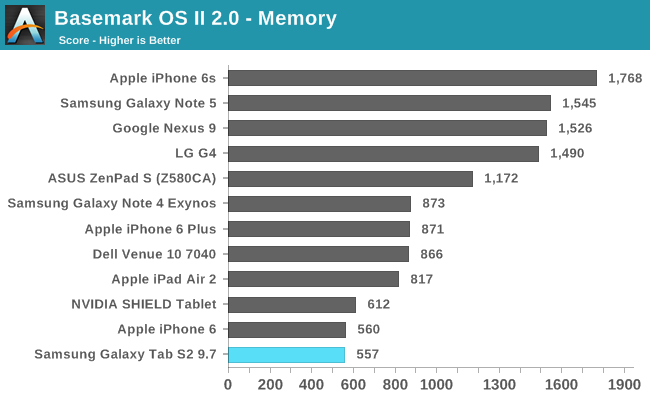

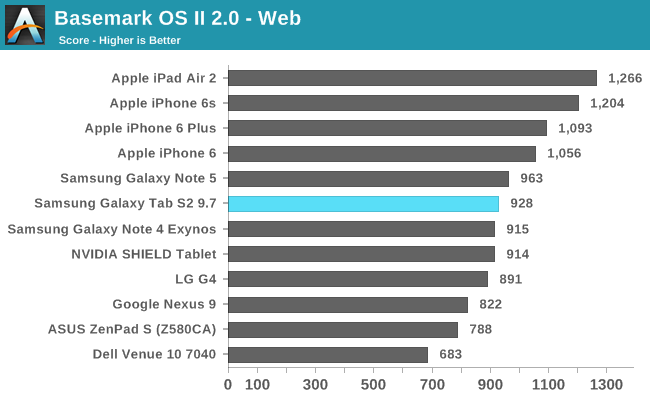
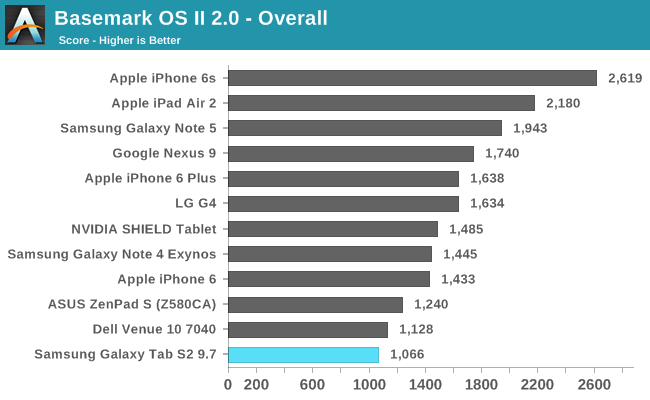
When examining the overall score in BaseMark OS II one may think that the Tab S2 performs extremely poorly. However, when looking at the sub tests it becomes clear that the overall score is being brought down by very low storage and graphics scores. What's surprising is the large gap between the graphics resuIts on the Tab S2 and the Galaxy Note 4 Exynos which uses the same Exynos 5433 SoC. I re-ran the benchmark several times to see if there was anything strange going on but there doesn't appear to be any problem with the testing, and I'm not quite sure why there's such a large gap between the two.
Moving past storage and graphics, the Tab S2 gets fairly good scores in the web and system tests. However, it still lags very far behind the iPad Air 2, and there's really no way to excuse this when both devices cost the exact same amount.
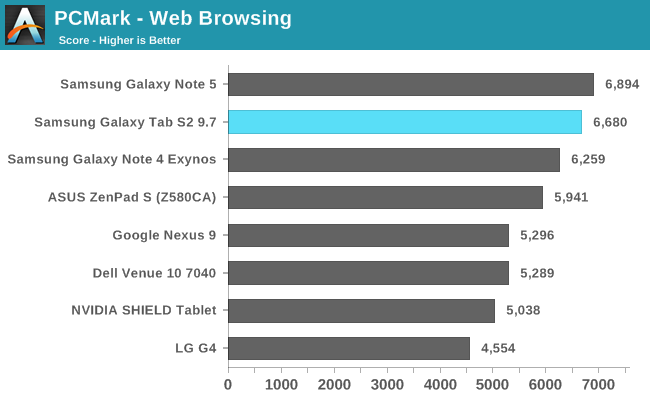



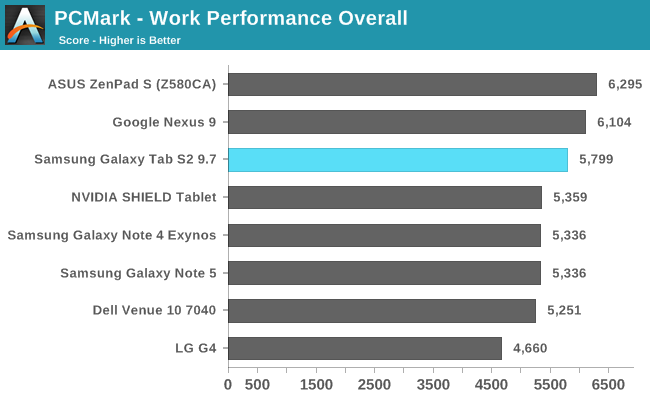
PCMark is still an Android only benchmark so the results here will strictly be comparing to other Android tablets. Overall, the Tab S2 does well. Upon examining the sub tests it can be seen that the Tab S2 is always fairly close the top of the charts, with certain devices achieving extraordinary scores in some tests which makes the Tab S2 look comparatively slower than it would be with more devices for comparison.
Exynos 5433 is not Samsung's best silicon, and even Exynos 7420 would likely struggle to compete with an SoC designed exclusively for full sized tablets. In the end the Tab S2's performance is just not competitive with the iPad Air 2 or even the Nexus 9 which is priced at $399 and often sells for even less. If I were looking at the 8" Tab S2 I would probably consider its performance acceptable relative to the competition at that size and price, but the market segment of full sized flagship tablets costing $500 or more is a completely other story.
I think Samsung definitely needs to reconsider their process of designing tablets, and part of that has to involve using chips that befit the larger size and greater capabilities of a tablet compared to a smartphone. It's in everyone's best interest to not have one company holding an enormous performance lead in any market, and if there's any company that has the capabilities, integration, and resources to fight with Apple over the tablet performance crown I would think it would be Samsung.










162 Comments
View All Comments
Brandon Chester - Thursday, October 15, 2015 - link
Thanks for the correction.extide - Thursday, October 15, 2015 - link
Exynos 5433 in late 2015?? WTF Samsung. At least you harped on it pretty hard in the review Brandon, and I agree that a custom designed tablet SOC would be the ideal, even the Exynos 7420 that they are putting in practically everything now would have been a huge improvement. It has a bigger GPU implementation, and the better process would help with power, and GPU throttling, which should clear up quite a few of the negatives of the overall device.extide - Thursday, October 15, 2015 - link
Hrmm, maybe they are using up all their 7420 / 14ff manufacturing capability with the 7420 (plus the A9/A9X) -- and are using up some of the much cheaper 20nm capacity that is just sitting around by using the 5433. Still seems like a bad idea though, I mean a premium device should have a premium SOC.Also, I think devices are thin enough. I'd rather add on a couple extra mm and have more battery capacity.
johnny_boy - Thursday, October 15, 2015 - link
Despite the better display and dimensions, I would still go Nexus 9 over Samsung. It's cheaper, faster, running the latest near-stock Android, and will continue to get the latest updates well into the future. That said, I don't think software updates are as huge a deal as people make them out to be, at least now that Google ships basically all their core apps/services through the Play Store.Solandri - Thursday, October 15, 2015 - link
"moving away from the 16:10 aspect ratio and adopting a 4:3 display ratio which is very close to the 8.5x11" paper used in North America"This is incorrect. 4:3 (1.33 aspect ratio) is close to 8.5x11" (1.294 aspect ratio) only if you include the margins of the paper. That is, your tablet has bezels, then you waste pixels on white margins, then display the actual information content of the page.
Quite frankly, that's stupid. You're paying hundreds of dollars for the extra 2-3 diagonal inches of a 10" tablet over a 7-8 inch tablet. Why waste that extra screen space displaying margins? The tablet already has a bezel which provides whitespace (or blackspace) around the edges, just like margins. Allowing you to pick it up and hold it without covering up any information.
If you subtract the margins, 8.5x11 with 1" margins becomes 6.5x9 or a 1.385 aspect ratio. With 1.5" margins (common with low-density business correspondence) it's 5.5x8 with a 1.455 aspect ratio.
A4 is 210x297mm, or a 1.414 aspect ratio. With standard 2.5cm margins, it becomes 160x247mm and a 1.544 aspect ratio.
The Time magazine format is 8.25x10.75. Without margins, the "live" area is 7x10, or 1.429 aspect ratio.
National Geographic is 7.125x10.24. It's live area is 6.125x9.25, or a 1.510 aspect ratio.
Combine that with tablets frequently being used to display 16:9 movies (1.77), and a 3:2 aspect ratio (1.5) is probably ideal.
Spectrophobic - Thursday, October 15, 2015 - link
Yes, 16:10 and 3:2 are still the better choice for high-end tablets considering its specs are more suited for multimedia consumption. I honestly think 4:3 are more suited for mid-/lower-end tablets which more or less being used as e-readers.My personal favourite resolution is 1920 x 1280 (3:2) found on the Surface 3. Slightly better than 1920 x 1200 and allows me to watch 720p videos 1:1 when on portrait. Yes, the letterboxing is immense, but I'll take it over interpolating it to 1920 x 1080 or having black bars on all four corners... But that's just me.
R. Hunt - Friday, October 16, 2015 - link
16:10 is just horrible IMHO for anything other than watching video. 3:2 at least is usable in both orientations.Spectrophobic - Friday, October 16, 2015 - link
Well, it's just a matter of preference. I like the 16:10 more as I view more vertical scrolling websites more and watch a lot of 16:9 content (YouTube, anime, etc.).Also, for Android at least, 3:2 is pretty much non-existent.
IUU - Thursday, October 15, 2015 - link
A tablet is useful primarily for it's portability. As much as it could bring from the desktop for a longer period of time is most wanted.Reducing thickness to beat Apple in fashion and slickness , while reducing battery capacity is childish and a grave mistake. It could keep the previous thickness or even increase thickness by 1 or 2 mm as long as it would provide us with a 15 hr lasting battery , or more.
In addition we are approaching dangerously the 1st quarter of 21st century. Putting 16 or 32 or 64 gb of internal storage is hilarious to put it kindly no matter what cloud options you have. Also, a limited amount of peripheral ports slowly grows to being more than a defect.
Further more, speaking too much of performance makes no sense, both because despite all their improvements these are weak processors with many cores only to deceive the naïve.
Even if this is not so, you can't do many things with them to justify "uping" the performance. A tablet to be useful(ie to provide its resources for work) it should be able to connect to just about every monitor keyboard, mouse and computer and not adopt some obscure connection protocols in case they miss a dollar or a penny and consumers don't buy their screens.
For now they are excellent consumptions devices and could become great creativity tools if Samsung and Apple weren't so narrow-minded and stubborn and pushing them more as fashion and entertainment devices rather than serious computing machines. Despite their limitations these devices could be useful even now, but these businesses don't realise the potential. Maybe it's for the best , someone else will, and will disrupt their practices.
name99 - Thursday, October 15, 2015 - link
"Samsung has settled on 8.0" and 9.7", the latter of which surprises me as it's the exact same size as the standard iPad"Sure, "surprise", that's the right word...
Will you be similarly "surprised" when Samsung introduces a feature very much like 3D-Touch and haptic feedback very much like the Taptic engine? Because I assure you the rest of us will not...